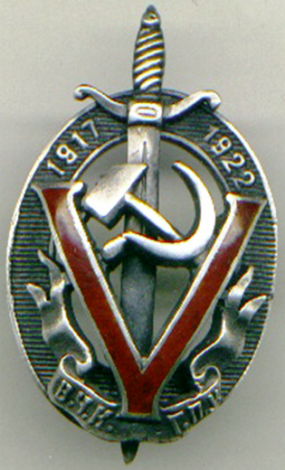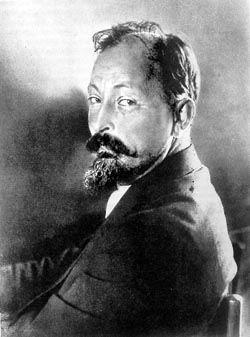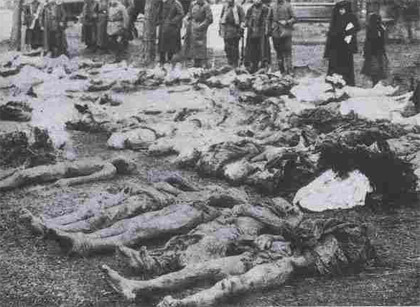
The CHEKA (sometimes called VeCHEKA) was the much-feared Bolshevik secret police – though to most Russians the CHEKA was no secret. The CHEKA was formed in the wake of the October 1917 revolution, established as a small agency to investigate and deal with threats to the new regime. It was to be the “sword and shield of the revolution”, defending the Soviet regime by attacking its enemies within. But as opposition to the new regime grew through 1918 so too did the size and scope of the CHEKA. Led by Felix Dzerzhinsky, a fanatical Bolshevik and ruthless operator cut from a similar mould as Lenin, the CHEKA ballooned from a couple of hundred investigators to a bureaucratic and paramilitary behemoth, containing more than 100,000 agents. More significantly, the CHEKA operated outside the rule of law. It acted of its own accord, investigated and arrested whoever it chose, and answered to no one. The CHEKA became a model for 20th century secret police agencies in totalitarian states, including the Gestapo (Nazi Germany), the Stasi (East Germany) and the KGB (Soviet Russia).

Dzerzhinksy, like Lenin, had devoted his life to the Bolshevik cause. Born in Poland in 1877, Dzerzhinsky’s family were wealthy landed gentry with claims to a noble title, making him a most unlikely radical. Yet by the mid-1890s he was involved in Marxist political groups in the Baltic, before joining Lenin’s Bolshevik faction in 1906.
Dzerzhinksy spent more than a decade in prisons and labour camps before his release during the 1917 amnesty. In the lead up to the October Revolution, he became one of Lenin’s most trusted lieutenants. According to Louise Bryant, Dzerzhinsky adored Lenin and was “shy, aloof and deeply puritanical” – but he was also ruthless and dispassionate, hardened by years of abuse and persecution. “One feels he can neither understand nor forgive moral weaknesses in others, since he himself possesses that fanatical devotion which has made it possible for him to travel the hard, bitter road where his ideals lead”, Bryant wrote.
Dzerzhinsky’s incorruptible fanaticism and hard-heartedness earned him the epithets ‘Iron Felix’ and the ‘Iron Count’.

The CHEKA became the embodiment of Dzerzhinsky’s ruthlessness, just as the Bolsheviks had become the embodiment of Lenin’s obsessive impatience for revolution. On receiving the decree Dzerzhinsky began hand-picking Bolsheviks he knew could be trusted for the difficult task of securing the revolution: men who were neither corruptible nor squeamish. At first, the CHEKA was small and its operations were limited. By early March 1918, there were only 120 Chekists (CHEKA agents). But increased anti-Bolshevik activity, the onset of the Civil War, the failed Left SR uprising of July 1918 and the assassination attempt on Lenin the following month saw the ranks of the CHEKA grow exponentially. Given a virtual blank cheque by Lenin, Dzerzhinsky ordered the recruitment of thousands of new agents. He also organised CHEKA paramilitary units, which by the autumn of 1918 numbered 33 battalions and more than 20,000 men. By 1919 the CHEKA employed more than 100,000 people and was one of the largest and best-funded agencies of the Soviet state.
“Its original mandate was to root out the regime’s enemies: the counter-revolutionaries and saboteurs, enemy agents and speculators. In doing so, driven by revolutionary fervour and unrestrained by law, by 1922 the Cheka had penetrated virtually every area of life in Soviet Russia. It was active in assuring the food supply, in maintaining transport, in policing the Red Army and Navy, in monitoring the schools, and in ensuring that industries continued to function and deliver essential material to the state. It hunted down speculators and hoarders, sometimes cordoning off entire neighbourhoods during its massive operations. It surrounded villages and short peasants resisting the forced requisitions of grain, often leaving the peasants who remained alive without enough to eat. It even suppressed strikes by factory workers, the presumed rulers of the ‘workers’ state’.”
Michael Kort, historian
With this free rein, the CHEKA was able to persecute, detain, torture and summarily execute thousands of suspected spies, tsarists, counter-revolutionaries, kulaks, black marketeers and other ‘enemies of the state’. While the CHEKA’s methods drew on those used by the Okhrana, its size and willingness to use extra-legal killing soon surpassed the activities of the former tsarist security police. In its first two years, the CHEKA executed 900 people suspected of trading on the black market; another 600 bureaucrats were executed for “economic crimes”, mostly taking bribes. Official government figures suggest that just over 12,000 people were killed by Chekists in 1918-20. Some historians suggest that 200,000 or more are more realistic figures. Dzerzhinsky neither denied nor retreated from the CHEKA’s brutal role, declaring that “we stand for organised terror, terror being absolutely indispensable in the current revolutionary conditions”.
The ingenuity of the Cheka’s torture methods was matched only by the Spanish Inquisition. Each local Cheka had its own speciality. In Kharkov they went in for the ‘glove trick’ – burning the victim’s hands in boiling water until the blistered skin could be peeled off: this left the victims with raw and bleeding hands and their torturers with ‘human gloves’. The Tsaritsyn Cheka sawed its victims’ bones in half. In Voronezh, they rolled their naked victims in nail-studded barrels. In Armavir, they crushed their skulls by tightening a leather strap with an iron bolt around their head. In Kiev, they affixed a cage with rats to the victim’s torso and heated it so that the enraged rats ate their way through the victim’s guts in an effort to escape. In Odessa, they chained their victims to planks and pushed them slowly into a furnace or a tank of boiling water. A favourite winter torture was to pour water on the naked victims until they became living ice statues.
The CHEKA is often described as the ‘Bolshevik secret police’ but in reality, only some of its operations were secretive or concealed. The existence and activities of the CHEKA were widely known and many of its operations were conducted openly and publicly. Though CHEKA agents had no standard uniform, most wore long leather coats and could be easily identified. All this was purposely done: to show Russians that the CHEKA was everywhere and could deal swiftly with those who betrayed or opposed the Bolshevik regime. Some CHEKA killings were carried out more for public effect than any political purpose. In 1918 CHEKA agents appeared in the audience of a Moscow circus and began shooting after one of its clowns, Bim Bom, made fun of the Bolsheviks and their leaders. Another example of this public gesturing was Lenin’s famous order to the Penza CHEKA to hang at least 100 men, “and make sure that the hanging takes place in full view of the people”.

1. The CHEKA was the Bolshevik security force or secret police. It was formed by Vladimir Lenin in a December 1917 decree and charged with identifying and dealing with potential counter-revolutionaries.
2. The CHEKA was headed by Feliz Dzerzhinsky, a Bolshevik of Polish extraction. Dzerzhinsky was loyal to the point of fanaticism and had been hardened by years of imprisonment.
3. Initially very small with just a couple of hundred agents, the CHEKA grew rapidly during the turmoil and growing opposition of 1918. Within two years it had more than 100,000 employees.
4. CHEKA agents operated on their own accord, carrying out arrests, detention and executions. The CHEKA was not accountable to judges or courts and there was no legal oversight of its operations.
5. The CHEKA routinely used extra-legal violence and torture. This was sometimes done publicly, in order to provide a deterrent to those who might oppose the regime.
© Alpha History 2018. Content on this page may not be republished or distributed without permission. For more information please refer to our Terms of Use.
This page was written by Jennifer Llewellyn, John Rae and Steve Thompson. To reference this page, use the following citation:
J. Llewellyn et al, “The CHEKA” at Alpha History, https://alphahistory.com/russianrevolution/cheka/, 2018, accessed [date of last access].
